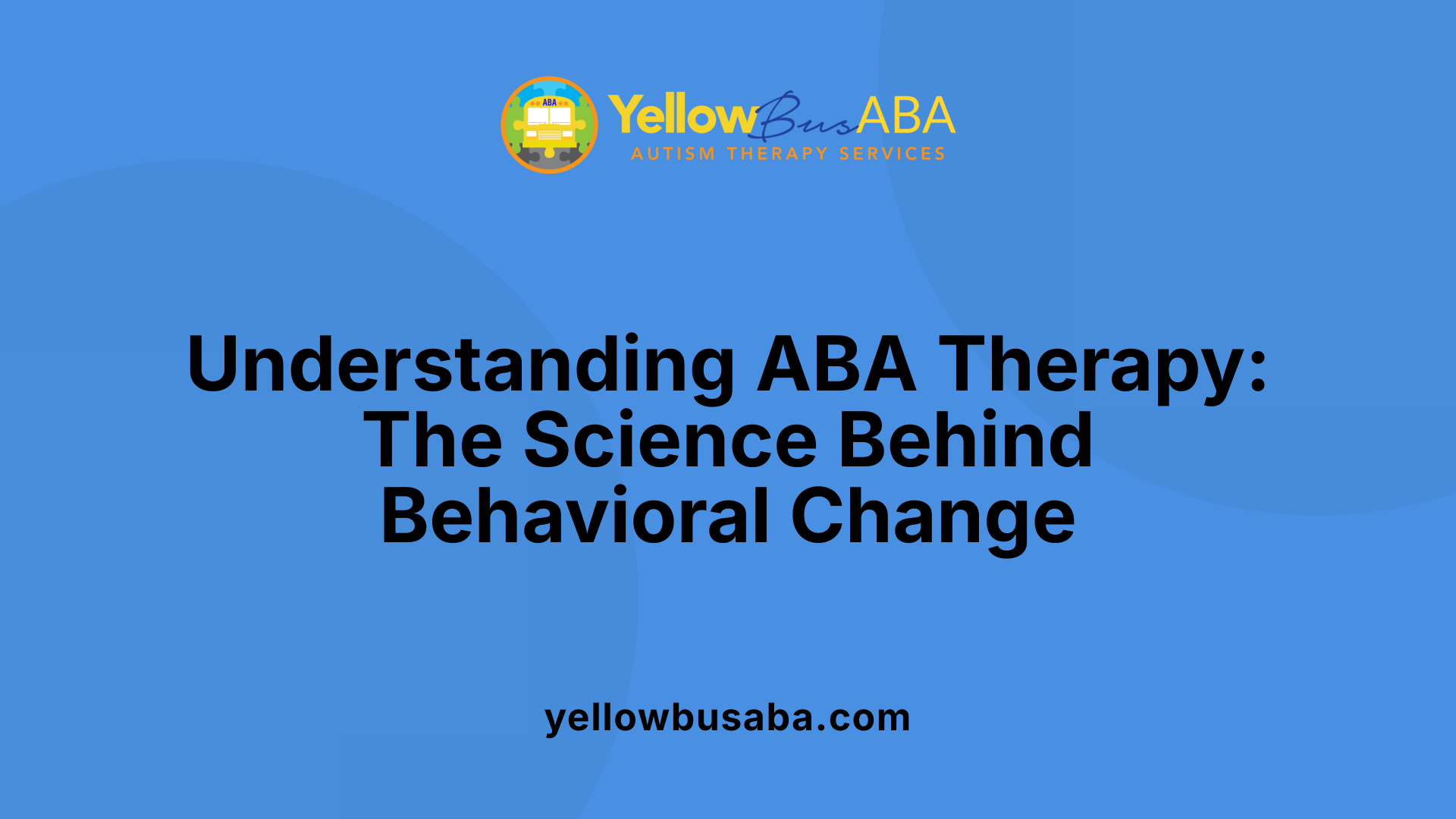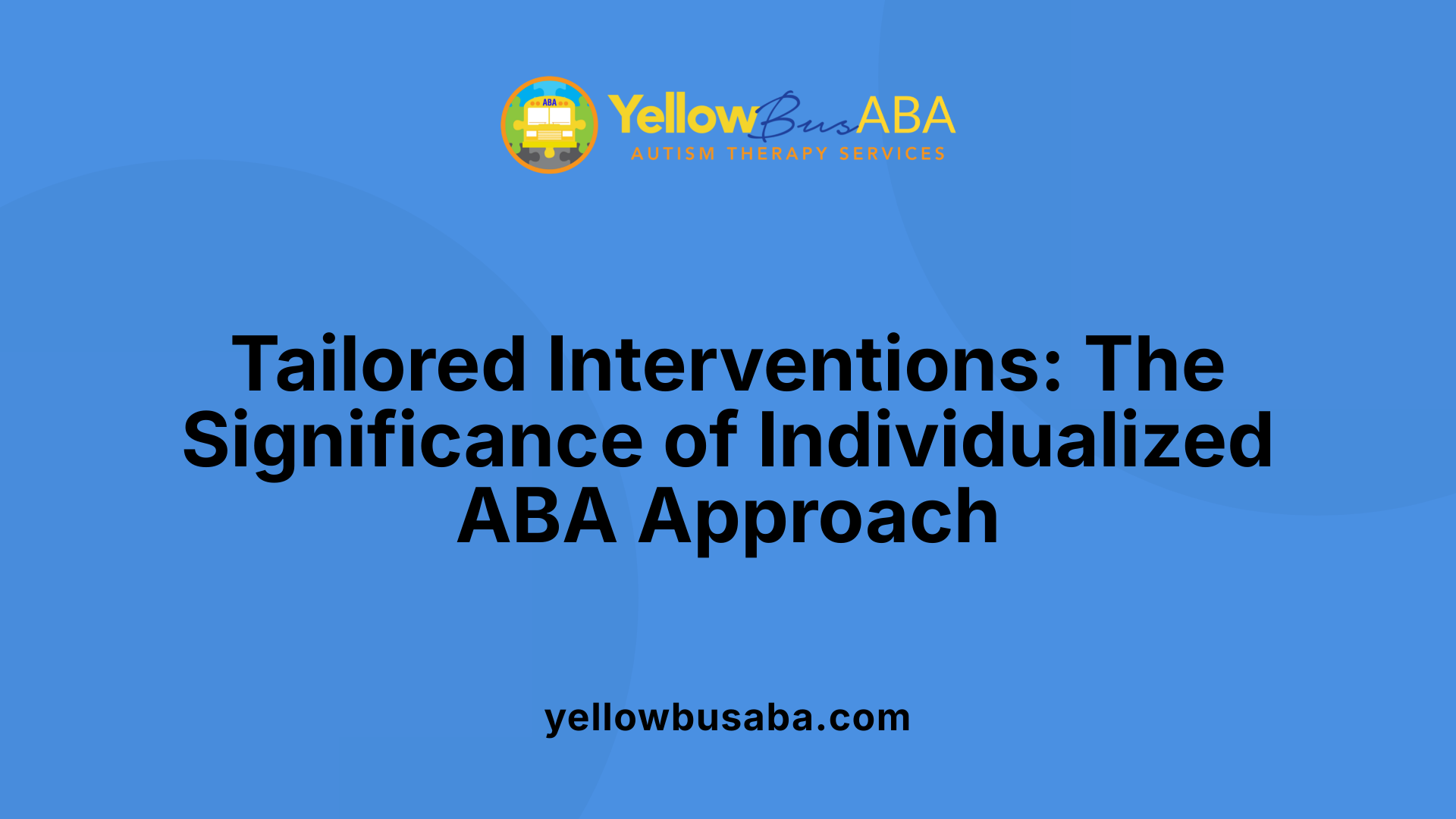The Power of One-on-One Attention in Behavior Therapy
November 13, 2025
How Personalized ABA Therapy Transforms Lives of Individuals with Autism

Understanding the Significance of One-on-One Attention in ABA Therapy
Applied Behavior Analysis (ABA) stands as a cornerstone in autism therapy, distinguished by its focus on individual needs. The one-on-one attention that ABA therapy entails is critical in creating a supportive environment tailor-made for each child's development. This personalized approach not only advances skill acquisition but also fosters meaningful behavioral change, ultimately enhancing quality of life.
What is Applied Behavior Analysis (ABA) Therapy?

Definition of ABA therapy
Applied behavior analysis (ABA) therapy is a science-based approach that helps children with autism improve skills and reduce problematic behaviors. It focuses on understanding how environmental factors influence behavior and uses targeted interventions to increase positive behaviors such as communication, social interaction, and self-care.
Scientific basis and principles
ABA is rooted in the science of learning and behavior. The therapy applies the principle that behaviors followed by positive consequences are likely to increase, while those without reinforcement tend to decrease. Techniques involve breaking down complex skills into smaller, teachable steps and systematically teaching them through prompting and reinforcement.
Role of positive reinforcement
Positive reinforcement is central to ABA therapy. It involves encouraging desired behaviors by providing immediate rewards or praise, which strengthens the likelihood of those behaviors recurring. This method has been scientifically validated and is widely used to promote skill acquisition and reduce undesirable behaviors.
ABC model overview
ABA employs the ABC model to understand behavior: antecedents (triggers or what happens before a behavior), behavior (the action itself), and consequences (what happens after). This model helps therapists identify what motivates behaviors and tailor interventions accordingly to encourage useful and reduce harmful behaviors.
Personalization and assessment
Every ABA program begins with a comprehensive assessment by a Board Certified Behavior Analyst (BCBA). The BCBA develops an individualized treatment plan based on the child's unique strengths and challenges. One-on-one therapy sessions allow for personalized interventions, continuous data collection, and ongoing adjustments to optimize progress.
Evidence-based effectiveness
ABA therapy’s effectiveness is supported by hundreds of studies demonstrating significant benefits in socialization, communication, and language skills. Early intensive ABA, often more than 20 hours per week in young children, can lead to substantial developmental gains and may reduce reliance on later special services. Because of its evidence-based nature, ABA is regarded as a gold standard treatment for autism and is frequently covered by insurance when medically necessary.
The Benefits of One-on-One ABA Therapy for Individuals with Autism

Skill development via personalized attention
One-on-one ABA therapy provides individualized attention that customizes interventions to a child's unique strengths and challenges. This personalized approach helps children develop essential skills such as communication, social interaction, self-care, and academic readiness in a way that suits their learning style.
Structured environments and tailored interventions
ABA sessions occur in structured settings where trained therapists implement carefully designed plans based on an initial assessment by a Board Certified Behavior Analyst (BCBA). This ensures that interventions are precise and focused on the child's specific needs.
Positive reinforcement and immediate feedback
A core principle of ABA is positive reinforcement, which strengthens desired behaviors through rewards. Immediate feedback during sessions helps children understand and repeat appropriate behaviors, accelerating learning and reducing problematic actions.
Promotion of independence and social skills
ABA therapy emphasizes increasing functional and socially significant behaviors, helping children gain independence in daily living and develop confidence in social settings. Techniques include teaching practical skills and facilitating social interactions through group activities and peer modeling.
Significance of early and intensive ABA
Starting ABA therapy early, with more than 20 hours per week during early childhood, can lead to substantial developmental gains. Early intervention not only enhances learning outcomes but may also reduce the need for more intensive special services later in life.
Long-term developmental gains
ABA supports lifelong learning and development, adjusting goals and methods based on continuous progress monitoring. With ongoing support, individuals with autism improve communication, socialization, and independence, fostering better participation in school, community, and adult life.
Who Provides ABA Therapy? Credentials and Roles Explained

Who provides ABA therapy and what qualifications do they have?
ABA therapy is delivered by professionals who specialize in behavior analysis and hold specific certifications relevant to ABA interventions.
Primary ABA providers and certifications
The most qualified practitioners are Board Certified Behavior Analysts (BCBAs). BCBAs assess clients, design individualized treatment plans, and oversee therapy to ensure it aligns with research-based practices.
Role of Board Certified Behavior Analysts (BCBAs)
BCBAs conduct thorough initial assessments and develop targeted strategies to address each child's unique strengths and needs. They supervise therapy implementation and modify plans based on ongoing data collection.
Function of Registered Behavior Technicians (RBTs)
Registered Behavior Technicians (RBTs) work directly with children during therapy sessions. Under BCBA supervision, they implement structured interventions, provide immediate feedback, and collect detailed data on progress.
Support from assistant behavior analysts (BCaBAs)
Board Certified Assistant Behavior Analysts (BCaBAs) support BCBAs by assisting in assessments, helping to supervise RBTs, and contributing to data analysis.
Collaborative teamwork with families and caregivers
ABA providers actively involve families, training caregivers to apply reinforcement strategies at home. This collaboration ensures consistency across environments and reinforces skill generalization.
Training and ethical standards
All ABA professionals adhere to rigorous training requirements and ethical guidelines. They commit to evidence-based practices and continuous professional development to provide effective and ethical care.
This multidisciplinary approach ensures that ABA therapy is tailored, data-driven, and delivered with professional expertise and family partnership.
From Structure to Flexibility: Evolution of ABA Therapy Approaches

Early Methods: Discrete Trial Training (DTT)
ABA therapy began with structured, repetitive techniques like Discrete Trial Training. In DTT, children with autism engage in one-on-one sessions where tasks are broken down into small, teachable steps. Each correct response is rewarded through positive reinforcement, helping children learn specific skills steadily and clearly.
Modern Approaches: Pivotal Response Treatment (PRT) and Early Start Denver Model (ESDM)
Contemporary ABA therapies have moved toward more flexible, play-based methods. Pivotal Response Treatment emphasizes following the child's interests and using natural reinforcement, creating a more engaging learning experience. The Early Start Denver Model integrates traditional ABA techniques with play activities, targeting multiple developmental goals within each session.
Play-Based, Natural Reinforcement Techniques
Modern ABA stresses the importance of learning through natural reinforcement. By embedding teaching moments in enjoyable, child-led interactions, therapy becomes more meaningful and motivating for the child. This approach helps generalize skills beyond the therapy setting, supporting real-life application.
Multiple Goal Integration During Therapy
Techniques like ESDM facilitate the simultaneous teaching of communication, social, motor, and cognitive skills during play activities. This holistic approach speeds skill acquisition and keeps children engaged through variety and relevance.
Benefits of Flexible and Engaging Methods
Shifting from rigid structures to flexible, play-based therapy improves engagement and motivation. It allows therapists to tailor sessions to each child's preferences, creating a positive learning environment. These methods better capture natural learning opportunities, increasing the likelihood that new skills will generalize to everyday situations.
The Importance of Individualized One-on-One Attention and Environment

Tailoring interventions to child's strengths and challenges
One-on-one ABA therapy allows trained therapists to focus on a child's unique strengths and challenges. By providing individualized attention, interventions are customized to meet the specific needs of each child, maximizing effectiveness and promoting steady progress.
Immediate feedback and reinforcement
During therapy sessions, immediate feedback and positive reinforcement are crucial. These responses help strengthen desired behaviors quickly, encouraging children to repeat them and reducing problematic behaviors over time.
Building rapport between therapist and child
A trusting and engaging relationship between the therapist and child enhances motivation and learning. This rapport creates a supportive environment where children feel comfortable experimenting with new skills and responding to guidance.
Flexibility of therapy settings: home, school, community
ABA therapy offers flexibility in delivery settings, including home, school, and community environments. This approach allows therapy to be seamlessly integrated into the child's daily surroundings, making learning more relevant and functional.
Integration into daily routines to reinforce skills
Embedding ABA sessions within everyday routines helps reinforce skills in real-life contexts. This integration improves generalization of learned behaviors, ensuring children apply skills beyond the therapy setting and fostering greater independence.
Parental Involvement: A Vital Component of Successful ABA Therapy
Training and Coaching for Parents
A fundamental element of applied behavior analysis (ABA) therapy for children with autism is the active involvement of parents. Therapists provide targeted training and coaching to caregivers, equipping them with effective strategies to support their child's learning journey at home. This education empowers parents to reinforce positive behaviors and implement intervention techniques consistently.
Consistent Reinforcement Beyond Therapy Sessions
Parental participation ensures that behavioral interventions extend beyond scheduled therapy hours. By applying ABA principles in daily routines, parents help maintain and strengthen the progress made during one-on-one sessions. Consistency in reinforcement across settings plays a crucial role in reducing problematic behaviors and fostering skill growth.
Building a Supportive Home Environment
Creating an environment conducive to learning is essential. Parents are guided to establish structured and predictable routines that encourage the use of newly acquired skills. This supportive atmosphere makes it easier for children to practice communication, social, and self-care abilities in familiar contexts.
Generalization of Skills Across Settings
Generalization refers to the transfer of skills learned in therapy to various real-world situations. Parent involvement facilitates this process by incorporating exercises and prompts into everyday activities at home, school, and community settings. This comprehensive approach helps children adapt their skills flexibly and confidently.
Empowering Caregivers as Active Partners
ABA therapy views parents as vital collaborators in the treatment team. Involving caregivers in goal-setting, progress monitoring, and decision-making promotes shared responsibility for the child's development. This partnership ensures interventions are tailored effectively and supports sustainable growth over time.
Data-Driven Progress Monitoring and Technological Advances in ABA
Continuous assessment and goal refinement
ABA therapy relies heavily on ongoing data collection to continuously assess a child's progress. Therapists systematically record behaviors and skill acquisitions during sessions, enabling them to evaluate the effectiveness of the intervention. This data-driven approach allows for regular refinement of therapy goals, ensuring that each child receives tailored support that matches their evolving needs.
Use of data to customize strategies
Data collected during ABA therapy sessions informs critical decisions about strategy adjustments. If a particular teaching method or reinforcement technique is not yielding expected results, therapists can rapidly modify their approach. This customization maximizes the therapy's impact by focusing on strategies that work best for the child.
Digital tracking tools and telehealth applications
Technological advances have introduced digital tracking tools that streamline data collection and analysis. These tools allow therapists to input and access detailed progress reports quickly, improving accuracy and efficiency in decision-making. Telehealth applications also enable remote therapy sessions, providing access to ABA services for families in underserved or rural areas, or when in-person visits are impractical.
Parent coaching apps and remote support
Parent involvement is critical in ABA therapy, and technology supports this through coaching apps and remote support platforms. These digital resources give caregivers training and guidance on implementing ABA strategies at home. They also offer a means of communication with therapists, facilitating consistency across settings and reinforcing skill generalization.
Evolving nature and accessibility of ABA therapy
The integration of technology in ABA exemplifies its evolving and adaptable nature. Digital tools and telehealth expand the reach of ABA therapy, making it more accessible to diverse populations. These innovations ensure that ABA remains a flexible, evidence-based intervention aligned with contemporary needs and advances in behavioral science.
Harnessing the Power of Personalized Attention in ABA
One-on-one attention within ABA therapy serves as a powerful catalyst for fostering growth in individuals with autism. Its individualized, data-driven approach ensures that interventions are responsive to each child's unique needs, creating a supportive environment that encourages meaningful skill development and behavioral improvements. Involving parents and integrating therapy across settings maximizes outcomes, while evolving methods and technologies continue to enhance accessibility and effectiveness. Ultimately, the personalized nature of ABA stands as a transformative tool, empowering individuals with autism to achieve greater independence and improved quality of life.
References
- What Is Applied Behavior Analysis (ABA)?
- Unlocking Potential: The Benefits of One-on-One ABA Therapy
- Applied Behavior Analysis (ABA)
- How ABA Behavior Analysis Is Reshaping Autism Treatment
- Applied Behavior Analysis (ABA)
- Applied Behavior Analysis (ABA)
- Who Qualifies for ABA Therapy: Eligibility Guide
- Understanding Your Child's ABA Therapy Providers
- Applied Behavior Analysis (ABA)






